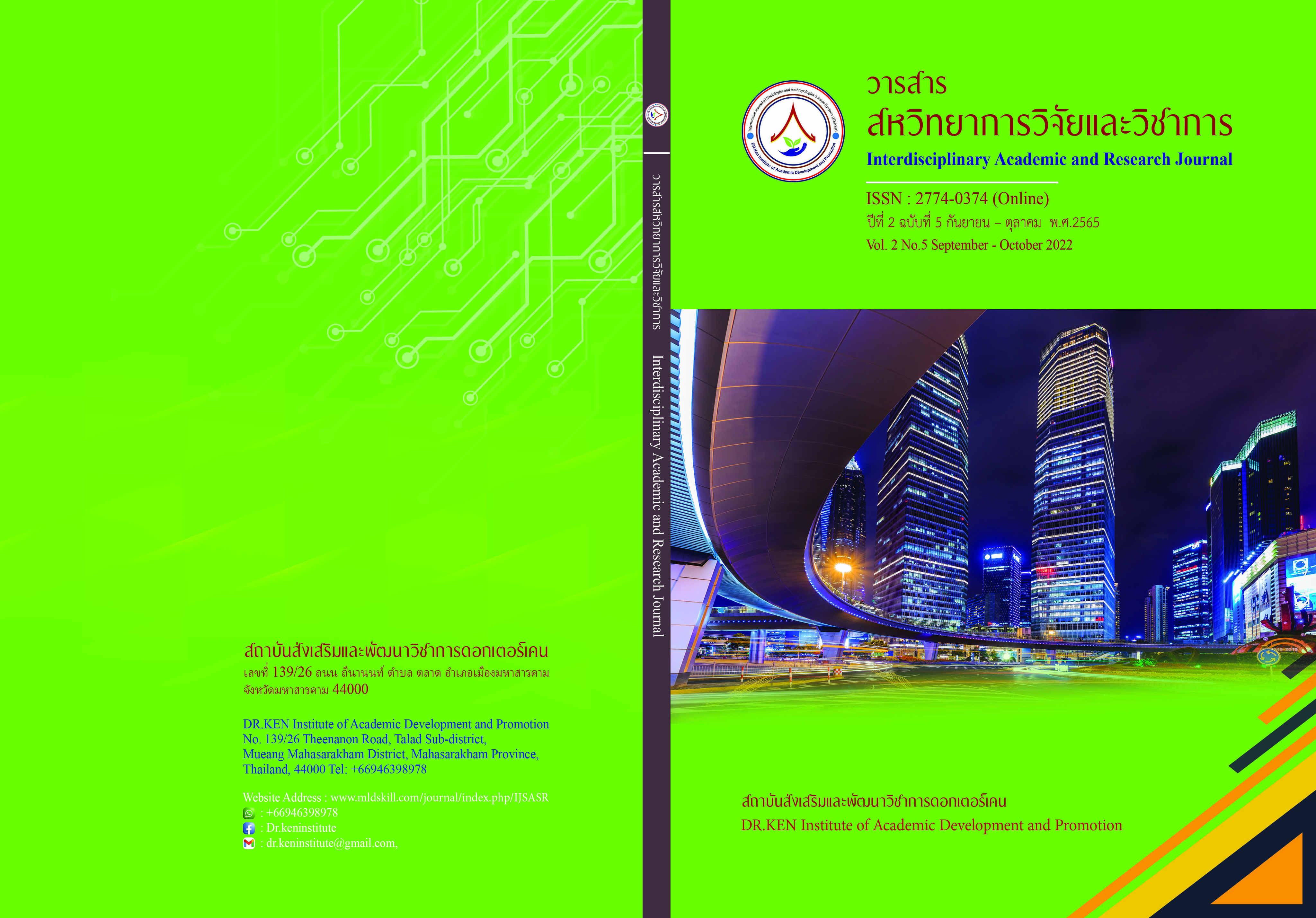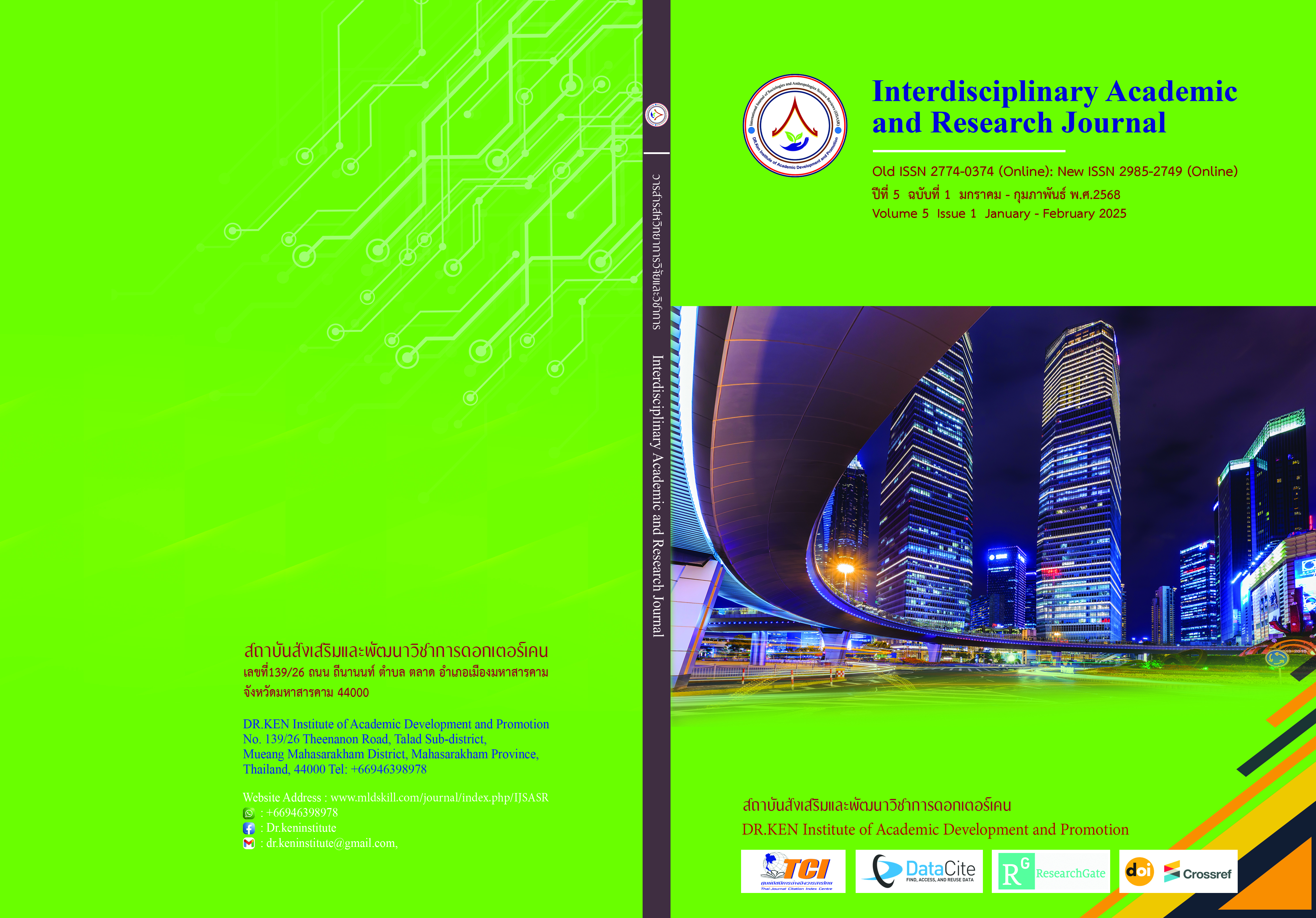ประสิทธิภาพการบริหารจัดการสินค้าคงคลังประเภทควบคุมอุณหภูมิ: กรณีศึกษา ร้านสะดวกซื้อ ในตำบลศาลายา จังหวัดนครปฐม
DOI:
https://doi.org/10.60027/iarj.2025.285151คำสำคัญ:
ปัจจัยด้านระบบการจัดการสินค้าคงคลัง, ประสิทธิภาพการบริหารจัดการสินค้าคงคลัง, สินค้าคงคลังประเภทควบคุมอุณหภูมิ, ด้านระบบการเติมเต็มสินค้า, ร้านสะดวกซื้อบทคัดย่อ
ภูมิหลังและวัตถุประสงค์: ปัจจุบันการจัดการโลจิสติกส์ เป็นเป้าหมายสำคัญที่ผู้ประกอบการสามารถใช้เป็นแหล่งที่มาของความได้เปรียบในการแข่งขัน ทั้งในระดับธุรกิจและระดับประเทศ เนื่องจากด้วยกระแสโลกาภิวัตน์ที่ส่งผลให้มีการแข่งขันทางธุรกิจที่รุนแรงเพิ่มมากขึ้น และการเปิดเสรีทางการค้าที่มากขึ้น ส่งผลให้ภาคธุรกิจจึงต้องยกระดับความสามารถในการดำเนินธุรกิจในทุกวิถีทางที่เป็นไปได้ งานวิจัยนี้มีวัตถุประสงค์เพื่อเพื่อศึกษาประสิทธิภาพการบริหารจัดการสินค้าคงคลังประเภทควบคุมอุณหภูมิ โดยศึกษาปัจจัยส่วนบุคคล ประสบการณ์การทำงาน จำนวนพนักงาน ตำแหน่ง รายได้เฉลี่ย/เดือน และศึกษาปัจจัยด้านระบบการจัดการสินค้าคงคลังที่มีอิทธิพลต่อประสิทธิภาพการบริหารจัดการสินค้าคงคลังประเภทควบคุมอุณหภูมิของร้านสะดวกซื้อ
ระเบียบวิธีการวิจัย: เครื่องมือที่ใช้เป็นแบบสอบถาม เก็บข้อมูลจากกลุ่มตัวอย่างจำนวน 15 ชุด และใช้วิธีการสัมภาษณ์โดยตรงจาก ผู้จัดการ และ พนักงานที่ดูแลเกี่ยวกับการควบคุมสินค้าคง สถิติที่ใช้ คือ ค่าร้อยละ ค่าเฉลี่ย ส่วนเบี่ยงเบนมาตรฐาน สถิติที่ใช้ในการทดสอบสมมติฐาน ได้แก่ การวิเคราะห์ความแปรปรวนทางเดียว (One-Way ANOVA)
ผลการวิจัย: พบว่า จากกลุ่มตัวอย่างของร้านสะดวกซื้อ จำนวน 15 คน พบว่า ส่วนใหญ่มีประสบการณ์การทำงาน 1 - 5 ปี มีจำนวนพนักงานระหว่าง 11 - 20 คน ตำแหน่งพนักงานทั่วไป และมีรายได้ส่วนตัวเฉลี่ย/เดือนระหว่าง 10,001 – 20,000 บาท ผลการทดสอบสมมติฐาน พบว่า ค่า Significance ของตัวแปร ประสบการณ์การทำงาน ตำแหน่ง และรายได้เฉลี่ย/เดือน มีค่ามากกว่าระดับนัยสำคัญ 0.05 แสดงว่า ประสบการณ์การทำงาน ตำแหน่ง และรายได้เฉลี่ย/เดือนที่แตกต่างกัน มีผลต่อประสิทธิภาพการบริหารจัดการสินค้าคงคลังประเภทควบคุมอุณหภูมิของร้านสะดวกซื้อ ในตำบลศาลายาจังหวัดนครปฐม ไม่แตกต่างกัน ผลการทดสอบสัมประสิทธิ์การถดถอย พบว่า มีตัวแปรอิสระเพียง 1 ตัวเท่านั้นที่ส่งผลอย่างมีนัยสำคัญต่อประสิทธิภาพการบริหารจัดการสินค้าคงคลังประเภทควบคุมอุณหภูมิของร้านสะดวกซื้อ คือ ด้านระบบการเติมเต็มสินค้า โดยค่าสัมประสิทธิ์ของการพยากรณ์ เท่ากับ ร้อยละ 40.8 ส่วนที่เหลือ อีกร้อยละ 59.2 คือ ปัจจัยอื่นนอกเหนือจากที่ได้กล่าวมา ด้านระบบการเติมเต็มสินค้า ซึ่งจากผลการวิจัยผู้ประกอบการควรให้ความสำคัญในด้านการเติมเต็มสินค้าเป็นอย่างมาก เพื่อให้สามารถมีสินค้าคงคลังบริการลูกค้าในปริมาณที่เพียงพอ และทันต่อการความต้องการของลูกค้าเสมอเพื่อให้สามารถมีสินค้าคงคลังบริการลูกค้าในปริมาณที่เพียงพอ และทันต่อการความต้องการของลูกค้าเสมอ
สรุปผล: ประสบการณ์การทำงาน ตำแหน่ง และรายได้เฉลี่ย/เดือนไม่มีผลต่อประสิทธิภาพการบริหารจัดการสินค้าคงคลังควบคุมอุณหภูมิของร้านสะดวกซื้อในตำบลศาลายา ส่วนระบบการเติมเต็มสินค้ามีผลสำคัญต่อประสิทธิภาพนี้ ร้อยละ 40.8. การเติมเต็มสินค้าถือเป็นปัจจัยที่ผู้ประกอบการควรให้ความสำคัญเพื่อให้สินค้าคงคลังเพียงพอและตอบสนองความต้องการของลูกค้าได้ทันเวลา
References
โกศล ดีศีลธรรม และสุภาวดี วิทยาประพันธ์. (2547). การบริหารสินค้าคงคลัง :จากคลังสินค้าสู่ศูนย์กระจายสินค้า. กรุงเทพฯ: ธรรมกมลการพิมพ์.
จุฑาทิพย์ ลีลาธนาพิพัฒน์ และธีระวัฒน์ จันทึก. (2561). การจัดการสินค้าคงคลังอย่างมืออาชีพ. Veridian E-Journal, Silpakorn University, 11(1), 226-241.
ปฐมพงษ์ หอมศรี และจักรพรรณ คงธนะ. (2557). การพัฒนาระบบการจัดการสินค้าคงคลัง :
กรณีศึกษาบริษัทติดตั้งและบำรุงรักษาเครื่องจักรของโรงงาน SME. วารสารวิชาการคณะ
เทคโนโลยีอุตสาหกรรม มหาวิทยาลัยราชภัฎลำปาง, 7(2), หน้า 42-56.
สมชาย วรกิจเกษมสกุล. (2554). ระเบียบวิธีการวิจัยทางพฤติกรรมศาสตร์และสังคมศาสตร์. สำนักงานคณะกรรมการการอุดมศึกษา.
สุมินตรา หินดำ และนันทิ สุทธิการนฤนัย. (2563). แนวทางการเพิ่มประสิทธิภาพการจัดการสินค้าคงคลังกรณีศึกษา: บริษัท ABC จํากัด. คณะวิศวกรรมศาสตร์. มหาวิทยาลัยหอการค้าไทย.
อภิชาติ โสภาแดง. (2553) การสร้างเครืองข่ายการรวมกลุ่มและเชื่อมโยงข้อมูลของเกษตรกรและชุมชน กรณีศึกษา: โซ่อุปทานลำไยนอกฤดู. กรุงเทพฯ:สำนักงานกองทุนสนับสนุนการวิจัย: กรุงเทพฯ.
Axsäter, S. (2015). Inventory control (2nd ed.). Springer.
Bowersox, D. J., Closs, D. J., & Cooper, M. B. (2019). Supply chain logistics management (5th ed.). McGraw-Hill Education.
Caro, F., & Garcia, P. (2020). Supply chain disruptions and consumer behavior during COVID-19. International Journal of Logistics Management, 31(4), 481-503. https://doi.org/10.1108/IJLM-03-2020-0143
Chopra, S., & Meindl, P. (2016). Supply chain management: Strategy, planning, and operation (6th ed.). Pearson Education.
Christopher, M. (2016). Logistics & supply chain management (5th ed.). Pearson Education.
Chung, C. (2020). The impact of COVID-19 on consumer behavior and retail business. International Journal of Retail & Distribution Management, 48(9), 945-958. https://doi.org/10.1108/IJRDM-03-2020-0115
Harrison, A., & Van Hoek, R. (2014). Logistics management and strategy: Competing through the supply chain (5th ed.). Pearson Education.
Heizer, J., Render, B., & Munson, C. (2017). Operations management: Sustainability and supply chain management (12th ed.). Pearson Education.
Ivanov, D. (2020). Predicting the impacts of epidemic outbreaks on global supply chains: A simulation-based analysis of the COVID-19 pandemic. International Journal of Production Research, 58(15), 4887-4903. https://doi.org/10.1080/00207543.2020.1751782
Kim, S. (2021). Retail business strategies during economic downturns. Journal of Business Research, 132, 234-241. https://doi.org/10.1016/j.jbusres.2021.02.034
Yamane, Taro. (1973). Statistics an introductory analysis. New York Harper & Row.
Downloads
เผยแพร่แล้ว
How to Cite
ฉบับ
บท
License
Copyright (c) 2025 Interdisciplinary Academic and Research Journal

This work is licensed under a Creative Commons Attribution-NonCommercial-NoDerivatives 4.0 International License.
ลิขสิทธิ์ในบทความใดๆ ใน Interdisciplinary Academic and Research Journal ยังคงเป็นของผู้เขียนภายใต้ ภายใต้ Creative Commons Attribution-NonCommercial-NoDerivatives 4.0 International License การอนุญาตให้ใช้ข้อความ เนื้อหา รูปภาพ ฯลฯ ของสิ่งพิมพ์ ผู้ใช้ใดๆ เพื่ออ่าน ดาวน์โหลด คัดลอก แจกจ่าย พิมพ์ ค้นหา หรือลิงก์ไปยังบทความฉบับเต็ม รวบรวมข้อมูลเพื่อจัดทำดัชนี ส่งต่อเป็นข้อมูลไปยังซอฟต์แวร์ หรือใช้เพื่อวัตถุประสงค์ทางกฎหมายอื่นใด แต่ห้ามนำไปใช้ในเชิงพาณิชย์หรือด้วยเจตนาที่จะเป็นประโยชน์ต่อธุรกิจใดๆ














